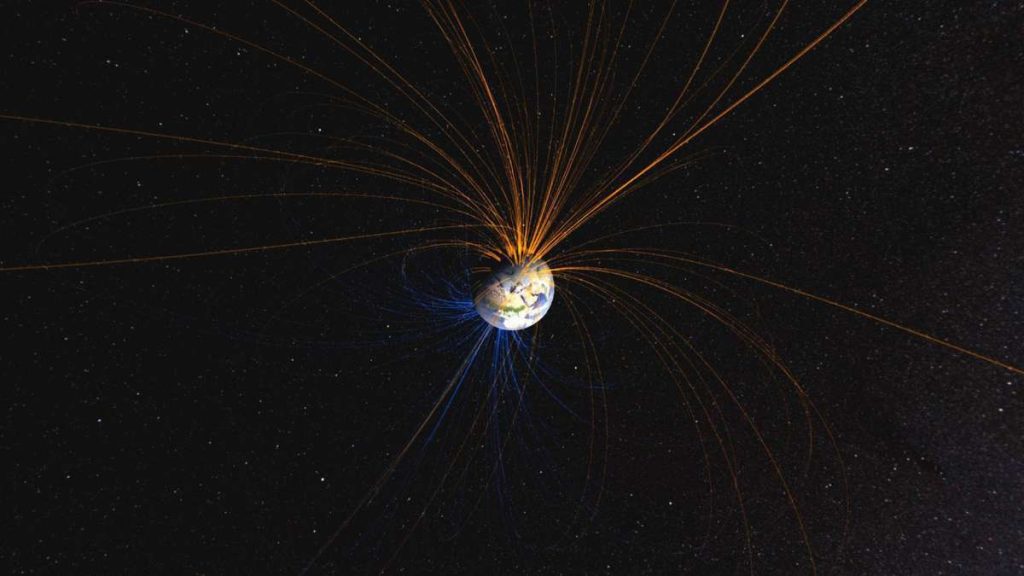-
fromPamela Doerhofer
Close
A British research team is providing insights into how humans might live on Mars. Radiation on the planet poses a particular challenge.
OXFORD – Mars colonies have been a reality in science fiction for decades. But could our red neighbor actually become a second home for our species, a place where people can move freely without thick suits, strong helmets, massive protection from radiation and other artificial systems? A team led by physicist Ruth Bamford from the University of Oxford (Great Britain) has an idea of how to make Mars more habitable: in a study published in the specialized journal “Acta Astronautica”, researchers explain how to find the Red Planet an artificial magnetic field that acts as a shield against radiation . The Martian moon Phobos plays a crucial role in their considerations.
As of today, it appears that there are enormous obstacles in the way of colonizing Mars. Although it belongs to the class of Earth-like planets, its day is about as long as a day on Earth, and there is frozen water beneath the surface. However, conditions on the surface are hostile to life. With a dominant double-digit minus degree, the atmosphere is much cooler than it is on Earth, and the atmosphere is made up of 95 percent carbon dioxide.
Is Mars habitable? High radiation must be protected
Therefore, long-term human presence on Mars requires “rehabilitation,” the Oxford physicists wrote in their study. This term means turning a planet into a habitable celestial body with the help of future technologies. Creating breathable air and food supply would at least be expensive, and the lower gravitational force would probably get used to it.
However, one of the biggest problems on Mars is the amount of radiation that humans may be exposed to. Because unlike Earth, the Red Planet only has a thin atmosphere and no protective magnetic field. Both are related. Without a strong surrounding magnetosphere, Mars cannot maintain a dense atmosphere in the long term. In fact, the red planet had a thick, water-rich atmosphere. However, without the protection of the magnetic field, it was increasingly eroded by the solar wind, and at some point it was exhausted.
Above all, without a protective shield, dangerous rays can reach the surface almost unimpeded. Because the task of the magnetic field is to protect the planet from the solar wind and high-energy ionizing particles, both from the sun and from the depths of the universe. This is why only a fraction of cosmic rays reach the Earth; It is intercepted and deflected by the magnetic field. Measurements by the NASA spacecraft Curiosity showed an average radiation dose of 77 microsieverts per hour during the flight to the surface of Mars and 26 microsieverts per hour at the surface. For comparison: on Earth, the values are between 0.05 and 0.2 microsieverts per hour.
Life on other planets: the research team wants to repurpose the Martian moon
Now, of course, the Earth’s magnetic field cannot be reproduced so easily. It is created by the influence of the dynamo in the Earth’s mineral core, which in turn comes about through the rotation of the Earth with the movement of tectonic plates. This does not work on Mars because the interior is smaller and colder.
So, what do physicist Ruth Bamford and her team imagine when they write about Mars’ “artificial magnetosphere”? They wrote that the proposed “optimal solution” is “entirely new.” In their model, Phobos, which is the two largest moons on Mars, is used to build a magnetic field. Like Earth’s satellite, it orbits the planet Earth, which orbits every eight hours. The distance to the surface is only 6000 km.
The researchers want to use this to build a plasmatorus, a “synthetically charged particle ring” around Mars. The model of this radiation belt is the moon Io, which forms such a ring around the gas giant Jupiter. For this purpose, the particles on Phobos must be ionized and accelerated so that they form a plasma ring along the Moon’s orbit. Bramford and her team are convinced that this, in turn, should generate a magnetic field that should be strong enough to protect the Martian atmosphere. In the opinion of the study authors, this is the “solution with minimal performance, order, and mass.”
Phobos is the largest of the two moons of Mars. NASA / government
© NASA/Government
‘A new era of space exploration’: a new study of Mars habitation
This all sounds reasonable, but it’s also too complicated to implement with today’s possibilities. But if people start making Mars habitable through rehabilitation, they must be prepared for problems and have ideas for solutions ready, as Oxford physicists wrote: “Now begins a new era of space exploration, and it is time to think of new and bold concepts for the future.” “.
The colonization of Mars should not be considered immediately. The principles examined in the study can also be applied to projects of small scale. Manned spacecraft, space stations, or lunar bases could also benefit from creating small, protective magnetic casings. (Pamela Doerhofer)
Only recently, NASA’s “Perseverance” rover has solved one of the greatest mysteries on Mars – and it hasn’t even begun.

“Tv expert. Hardcore creator. Extreme music fan. Lifelong twitter geek. Certified travel enthusiast. Baconaholic. Pop culture nerd. Reader. Freelance student.”







More Stories
Space in City Hall has become more expensive
7 tips on how to learn to deal with your fears
“The kind of stone we were hoping to find.”